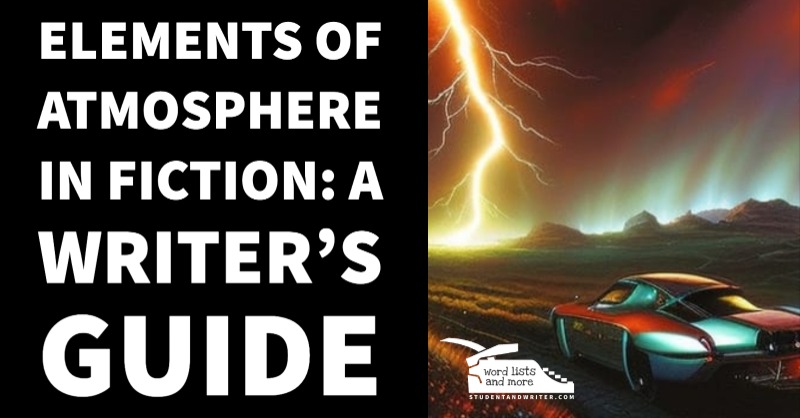How to Use Weather, Seasons, Time of Day, Location, Senses, Emotions, and Theme to Create Atmosphere in Your Fiction.
- Weather: The weather can play a big role in setting the atmosphere of your story. For example, a dark and stormy night can create a sense of suspense or foreboding, while a sunny summer day can create a sense of peace or tranquility.
- A dark and stormy night: This type of weather can create a sense of suspense, foreboding, or even terror. It can be used to foreshadow a coming event, or to create a sense of unease in the reader. For example, in the novel “The Shining” by Stephen King, the setting of a remote hotel during a snowstorm creates a sense of isolation and dread.
- A sunny summer day: This type of weather can create a sense of peace, tranquility, or even happiness. It can be used to set a relaxing or optimistic tone, or to contrast with a darker atmosphere. For example, in the novel “To Kill a Mockingbird” by Harper Lee, the setting of a small town in Alabama during the summer creates a sense of innocence and possibility.
- A cold and snowy winter: This type of weather can create a sense of isolation, loneliness, or even despair. It can be used to highlight the harshness of the world, or to create a sense of longing for warmth and comfort. For example, in the novel “The Road” by Cormac McCarthy, the setting of a post-apocalyptic world during a winter storm creates a sense of hopelessness and despair.
- A gentle spring rain: This type of weather can create a sense of hope, renewal, or even romance. It can be used to set a peaceful or romantic tone, or to contrast with a darker atmosphere. For example, in the novel “Pride and Prejudice” by Jane Austen, the setting of a country estate during a spring rain creates a sense of beauty and possibility.
- Seasons: The seasons can also affect the atmosphere of your story. For example, a winter setting can create a sense of isolation or loneliness, while a spring setting can create a sense of hope or renewal.
- Winter: Winter is often associated with cold, darkness, and isolation. This can be used to create a sense of suspense, foreboding, or even terror. For example, a winter setting could be used to tell a story about a group of people who are stranded in a cabin during a snowstorm, or about a lone traveler who is lost in the woods.
- Spring: Spring is often associated with new beginnings, hope, and renewal. This can be used to create a sense of optimism, joy, or even romance. For example, a spring setting could be used to tell a story about a young couple who fall in love, or about a gardener who is preparing their garden for the new season.
- Summer: Summer is often associated with heat, sunshine, and activity. This can be used to create a sense of energy, excitement, or even danger. For example, a summer setting could be used to tell a story about a group of friends who go on a road trip, or about a firefighter who is battling a forest fire.
- Fall: Fall is often associated with change, harvest, and the end of summer. This can be used to create a sense of nostalgia, melancholy, or even hope. For example, a fall setting could be used to tell a story about a family who is harvesting their crops, or about a young person who is leaving home for the first time.
- Time of day: The time of day can also affect the atmosphere of your story. For example, a night setting can create a sense of mystery or danger, while a day setting can create a sense of openness or possibility.
- Night: Nighttime can be a time of mystery, danger, and suspense. The darkness can hide all sorts of things, and the silence can be deafening. Writers can use this to their advantage by creating a sense of unease or foreboding in their readers. For example, a character might be walking home alone at night when they start to hear strange noises. The noises could be coming from anywhere, and the character doesn’t know who or what is making them. This creates a sense of suspense and fear in the reader, who is left wondering what will happen next.
- Day: Daytime can be a time of openness, possibility, and hope. The sun is shining, the birds are singing, and the world seems full of potential. Writers can use this to their advantage by creating a sense of optimism or excitement in their readers. For example, a character might be starting a new job on a beautiful sunny day. The character is excited about the new opportunity, and the reader feels that excitement too. The bright sunlight and cheerful atmosphere make the reader feel hopeful about the character’s future.
- Location: The location of your story can also affect the atmosphere. For example, a setting in a forest can create a sense of peace and tranquility, while a setting in a city can create a sense of excitement or danger.
- A forest: A forest can create a sense of peace and tranquility, especially if it is described as being lush, green, and quiet. The sound of birdsong, the smell of pine needles, and the feel of the cool, crisp air can all contribute to a sense of calm and serenity.
- A city: A city can create a sense of excitement or danger, depending on the way it is described. The hustle and bustle of traffic, the sound of sirens, and the sight of tall buildings can all create a sense of energy and excitement. However, a city can also be described as being crowded, noisy, and polluted, which can create a sense of danger or unease.
- A desert: A desert can create a sense of isolation and loneliness. The vast expanse of sand, the scorching heat, and the lack of water can all contribute to a feeling of being alone and cut off from the rest of the world.
- A beach: A beach can create a sense of peace and relaxation. The sound of the waves crashing on the shore, the smell of the salty air, and the feel of the warm sand between your toes can all contribute to a feeling of well-being and contentment.
- A mountaintop: A mountaintop can create a sense of awe and wonder. The view from the top of a mountain can be breathtaking, and the feeling of being so high up can be exhilarating.
- Senses: The five senses can all be used to create atmosphere in your story. For example, you could describe the smell of the rain, the sound of the wind, the taste of the food, the feel of the clothes, or the sight of the landscape.
- Sight: The sight of a dark and stormy night can create a sense of suspense or foreboding, while the sight of a sunny summer day can create a sense of peace or tranquility.
- Sound: The sound of the wind howling through the trees can create a sense of isolation or loneliness, while the sound of birds singing in the morning can create a sense of hope or renewal.
- Smell: The smell of the rain can create a sense of freshness or cleansing, while the smell of food cooking can create a sense of comfort or nostalgia.
- Taste: The taste of food can evoke memories or emotions, and can also be used to create a sense of place or time. For example, the taste of a particular dish might remind a character of their childhood, or it might transport them to a different country or culture.
- Touch: The feel of the clothes on your skin can create a sense of warmth or cold, comfort or discomfort. It can also be used to create a sense of texture or atmosphere. For example, the feel of rough bark against your fingertips might create a sense of danger or suspense, while the feel of soft fur might create a sense of comfort or security.
- Emotions: The emotions of your characters can also affect the atmosphere of your story. For example, if your character is feeling scared, the atmosphere of your story will likely be suspenseful or even terrifying.
- Fear: Fear is one of the most powerful emotions that can be used to create atmosphere. A character who is feeling afraid will likely be tense, anxious, and on edge. This can create a sense of suspense or even terror for the reader.
- Sadness: Sadness can create a sense of melancholy or even despair in a story. A character who is feeling sad may be withdrawn, lonely, or even hopeless. This can create a somber or even tragic atmosphere.
- Joy: Joy is a positive emotion that can create a sense of happiness, hope, or even wonder in a story. A character who is feeling happy may be carefree, optimistic, or even playful. This can create a light-hearted or even whimsical atmosphere.
- Anger: Anger is a powerful emotion that can create a sense of tension, hostility, or even violence in a story. A character who is feeling angry may be aggressive, volatile, or even destructive. This can create a sense of danger or even threat for the reader.
- Love: Love is a complex emotion that can create a sense of warmth, intimacy, or even passion in a story. A character who is feeling love may be affectionate, caring, or even devoted. This can create a sense of romance or even tenderness.
- Theme: The theme of your story can also affect the atmosphere. For example, if your story is about the power of love, the atmosphere of your story will likely be hopeful or even romantic.
- If your story is about the power of love, the atmosphere of your story will likely be hopeful or even romantic. You could use descriptions of warm sunlight, blooming flowers, or gentle breezes to create a sense of peace and tranquility. You could also use dialogue that expresses love, hope, or optimism.
- If your story is about the dangers of greed, the atmosphere of your story will likely be dark and foreboding. You could use descriptions of dark alleyways, stormy nights, or ominous shadows to create a sense of suspense or danger. You could also use dialogue that expresses fear, suspicion, or distrust.
- If your story is about the importance of family, the atmosphere of your story will likely be warm and inviting. You could use descriptions of a cozy living room, a delicious home-cooked meal, or a laughter-filled family gathering to create a sense of warmth and belonging. You could also use dialogue that expresses love, support, or acceptance.
- Consider the overall tone of your story. If your story is meant to be suspenseful, you might want to use a darker, more ominous theme. If your story is meant to be heartwarming, you might want to use a lighter, more hopeful theme.
- Think about the specific emotions you want to evoke in your readers. Do you want them to feel scared, hopeful, sad, or angry? Once you know what emotions you want to evoke, you can start to choose details that will create that atmosphere.
- Be consistent with your theme. The theme of your story should be evident throughout the story, from the setting to the characters to the dialogue. If you’re inconsistent with your theme, it will be difficult for readers to connect with your story on an emotional level.



